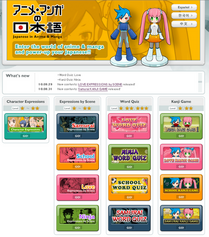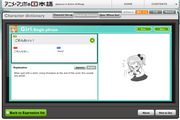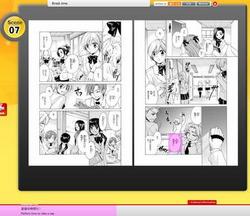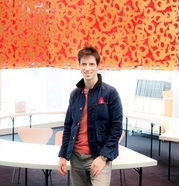Learning Japanese from Scratch and My Love for Japanese Culture (Part I)
 Message from Patrick Harlan
Message from Patrick Harlan
First off, I would like to express my sympathy to those who are in the affected areas or who have families and relatives there. I have never seen anything this hard in my 18 years in Japan. But, at the same time, the level of solidarity, patience and tireless efforts shown by people in the affected areas and all over Japan after the disaster of earthquakes and tsunamis was something I had never seen either. It is wonderful people in Japan are uniting and working together. As one of you, I am wishing for a swift recovery and reconstruction. I truly believe this country can do anything necessary to get over this event. Let's make a push together.
The following interview took place on March 8th, 2011
Patrick Harlan, known as Pakkun of the Japanese and American comedian duo Pakkun Makkun, shares his experience of learning Japanese. Here he talks with the creator of a Japanese language site about Japanese pop culture vs. traditional culture, his view of Japanese people, and different ideas of learning the Japanese language.
(Interviewed by Keiko Kawashima, Language Education Specialist at The Japan Foundation Japanese-Language Institute, Kansai ; Miyuki Akazawa, Lecturer at The Japan Foundation Japanese-Language Institute, Urawa)
I learned Japanese from scratch after arriving in Japan
――What got you started at learning Japanese?
Coming to Japan. I thought I had to speak Japanese as there are a lot of Japanese here. My friend who was coming to Japan asked me to come along but I had never studied Japanese nor did I even know much about the country. I was 23 years old, and that's when I started to learn Japanese pretty much from scratch.
 ――We understand you only knew about Japanese cars or something....
――We understand you only knew about Japanese cars or something....
And Ninja and Samurais. They're both extremely popular in the U.S. Do you know TV show called Teenage Mutant Ninja Turtles? They're turtles but are also ninjas and mutants. They wear headbands and use katana swords and nunchakus. Also, about 20 years ago, the dramatic mini-series, Shogun debuted on TV in the U.S. and was very popular. I've read the original story by James Clavell. Back then was also a period when Japanese were buying iconic buildings in America. This was called The Japanese Miracle.
――The Bubble Age, right?
Yes. I was a student at Harvard University and I thought I would make good money if I went to Japan. So I decided to go with my friend right before my graduation, but the bubble burst as soon as I landed and I was like, "Wait, this is not what I was told!"
――Then, you first went to Hokuriku region, right?
Yes I went to Fukui, which was so nice that I came to like Japan. People are just so kind and warm. My image of Japanese people was work focused, living in cramped apartments. But everyone in Fukui is family oriented, living in a big house, and driving cars, which is surprisingly quite like the American lifestyle. That's Japan. Tokyo is almost a different country. Well, this might be biased as I grew up on the Great Plains at the bottom of the Rocky Mountains, in the countryside of Colorado.
――How did you end up working in Fukui?
My friend worked in Fukui, so I figured I would live there too. I went to a police booth at a train station and asked, "Excuse me, is there any English language school around here?" I went to the one that policeman told me about and submitted my resume. I somehow got the job....
――That haphazardly?
That is how I live!
 When you learn a few Kanji (Chinese characters), the learning speeds up
When you learn a few Kanji (Chinese characters), the learning speeds up
――What was your first obstacle in learning Japanese?
At first, I didn't understand a thing. The word order to begin with. How does it become "I boy am" rather than "I am a boy?" Why is it, "I store fruit buy go?"
――In Japanese, the predicate follows the subject.
That's right. Then I hit the wall with non-subject expressions. With the American way, when I hear "Doing well?" I simply wonder, "Who is?" What's more extreme is, for example, if I was carrying a helmet, the Japanese would say "You bike?" They're asking "Did Patrick-san come on a bike?" but "You bike?" would not communicate that to Americans. So I answered, "No, I'm not A bike. I'm A human"... There were troubles like that.
――How was learning Kanji (Chinese characters)?
It was hard. But learning a fair amount of Kanji actually makes it very easy to boost your vocabulary level. Once you learn the numbers of the basics, they can be applied in various ways, and if you learn 100 Kanji, you'll learn the next 100 faster. When you learn 500, learning the next 500 and 1000 becomes three times faster.
――You would get the knack of it.
Yes. Learning Kanji allows you to break down words and understand the meaning of them.
The word "refrigerator" consists of three Kanjis, one meaning "chill", one meaning "stock house," and the other character used in the word "garage," which allows you to guess it probably means "storage" or "room". So when you combine the 3 characters, you can make your guess. When you say "refrigerator" in English, all you can explain is "re" sounds like "re" of "raisin" or something like that. So I find Japanese words to be rational.
But even after I learned how to read Kanji, it took me a long time to be able to write them. I still have a hard time. I can write a fair amount, but last year I tried the second highest certificate in Japanese Language Proficiency Test and was defeated honorably.
――It is quite challenging. Not even that many Japanese have that.
It's crazy hard. With some of them, I have no clue what they mean even if I could write them. But in the process, I learned the expression, "Yo-Kan-Ki-Ten." It's such a nice term and I want to use it. There's an English expression called "tunnel vision," which means you view things with a narrower focus. In a similar way, "Yo-Kan-Ki-Ten" means "peeping at the sky through a pipe." So I should use it to suggest viewing things on a bigger scale, like, "He's always thinking things in Yo-Kan-Ki-Ten!"
――I'm surprised you know that term. But I've never heard it in a conversation.
Right? I learned the word because I liked it, but when I use it people around me would be like, "Huh?" So I'm only learning those for my own satisfaction.
It's fun to hear the real audio of dialogues on the website
 ――You've passed the Level 1 of the Japanese Language Aptitude Test. Did you go to school for it?
――You've passed the Level 1 of the Japanese Language Aptitude Test. Did you go to school for it?
I passed Level 1 in the second year of my residence here. I studied on my own. I don't really like schools because they sometimes follow the pace of the slower learners. I always want to be the quickest to pick up. But to keep everyone up in a good pace is a job for some one with a higher caliber. I rather want to sprint in my own pace.
――You passed Level 1 by studying on your own for 2 years! But wasn't it difficult to practice speaking Japanese?
I learned speaking faster than I learned grammar. Since I was living in Japan, there were Japanese teachers everywhere. If I went to a sento, a public bath house, the person next to me would be a teacher; if I were out drinking, some drunk old man would become my teacher.
――Most people would study Japanese at least a little before they come here. The way you did it, coming here first and then learning, is quite rare. You must be like a challenge.
Well, it's stupid to go to a foreign country without studying. You can blend right in with the place faster if you know the basics. So I'm impressed with people who are checking out sites like Japanese in Anime & Manga.
 ――Like Pakkun in the old days, ideas of Japan for the young people overseas come from Pokemon and Naruto. Those animation or manga often become for many people the motivation for learning Japanese. Therefore, including terms used in those animation and manga in the source contents, helps people to study Japanese while having fun. This is the idea of the Japanese in Anime & Manga site.
――Like Pakkun in the old days, ideas of Japan for the young people overseas come from Pokemon and Naruto. Those animation or manga often become for many people the motivation for learning Japanese. Therefore, including terms used in those animation and manga in the source contents, helps people to study Japanese while having fun. This is the idea of the Japanese in Anime & Manga site.
I took a look at it and it is fun. People who like those animations would be hooked. There are some phrases, though, where I found myself wondering when I would use them.
 ――Commonly-used phrases are picked out from 160 comics that are popular overseas including Naruto, One Piece, and Bleach. Naturally, there are phrases that are used in the animation/comics world and not always used in real life.
――Commonly-used phrases are picked out from 160 comics that are popular overseas including Naruto, One Piece, and Bleach. Naturally, there are phrases that are used in the animation/comics world and not always used in real life.
That's why it's fun, though (laugh). There are not many butlers in real life that would say, "Welcome home, my majesty." I wonder when the tourist would need to use these expressions. But I suppose there are a lot more people watching the animation in their home country than ones that actually come to Japan and they would be excited to see the scenes with those phrases they have learned. Also, if you want to use that phrase, you could go to the Maid Cafe!
 ――Also, there are 4 genres on this site of most popular topics overseas: love, school, samurai, and ninja, where you can play games and listen to sounds while you have fun and learn Japanese.
――Also, there are 4 genres on this site of most popular topics overseas: love, school, samurai, and ninja, where you can play games and listen to sounds while you have fun and learn Japanese.
Oh, this is important right here, like this explanation section: "You can make it sound more like a girl if you end the sentence with a higher intonation." Things like this are what foreigners really want to know, but is hard to learn, and are often confused. If the teacher were a woman, all foreign male students would sound like a woman. I went though that myself.  On the site, the difference between boys' version of "sorry" and girls' version of "soooorrryyyy" is explained, which can be appreciated.
On the site, the difference between boys' version of "sorry" and girls' version of "soooorrryyyy" is explained, which can be appreciated.
Not 'Pi!' but 'Pah!' ? Onomatopoeic and imitative words are too funny
 ――We also introduce onomatopoeic words on the site but onomatopoeic words are really unique to Japanese, aren't they?
――We also introduce onomatopoeic words on the site but onomatopoeic words are really unique to Japanese, aren't they?
You can't really be fluent in Japanese without learning to use onomatopoeic and imitative words. There may not be any other language so rich with onomatopoeic and imitative words. They should say "fluent" like I do in Japanese, but they'd rather say "pera pera".. I am in charge of the English script of the animation Little Charo on NHK TV, but I had some trouble with its onomatopoeic terms. There are onomatopoeic words in English too, but imitative words are tough. When the script says "Stopping like 'pitah!'" or "Transforming in 'pah!'" there are no such sounding activity nor flashing??I don't understand "flashing"? Flash Cards? happening in the scene. There is no sound either. This "pah!' means "suddenly." But it doesn't feel right to translate them into words like "suddenly" or "at that moment" each time.
 For foreigners, the difference between "pah!" and "pi!" doesn't make sense. Why can't you stand up with "pi!"? Why is it "pah"? But for Japanese, it has to be "pah!" when you stand. Just from hearing the sound of a new onomatopoeic word, Japanese can picture what it means. It's such a mystery.
For foreigners, the difference between "pah!" and "pi!" doesn't make sense. Why can't you stand up with "pi!"? Why is it "pah"? But for Japanese, it has to be "pah!" when you stand. Just from hearing the sound of a new onomatopoeic word, Japanese can picture what it means. It's such a mystery.
The worst ones are the imitative words without sound. For example, there is an expression for silence such as "sheen." I am like, "Stop it! Why would you express the state of no sound in onomatopoeic!!"
――But for Japanese, it's more communicative to express silence by saying "Sheen."
But we can't help to think there's that sound "sheen" there. It is interesting. Onomatopeic and imitative words are the ones learners have a really hard time with and, at the same time, something animations and comics can teach. You can understand and learn the sound of the words such as "d.doon" and "bshaaan" along with what's happening in the picture.
Creating own stories to learn Kanji is the Pakkun style
 In the beginner level of Ninja Kanji Game, there is the word "bereave,"
which would probably be in Level 2 in the Japanese Language Proficiency Test. A hard one. Overall it seems that the Kanjis here would be between Level 3 to the one higher. I would've used this site if it was around when I was learning. I love Kanji. Since I memorize them in my own way, I have a sense of affinity for each one. Can you write the character "Ki" in the "Yo-Kan-Ki-Ten" I was talking about earlier?
In the beginner level of Ninja Kanji Game, there is the word "bereave,"
which would probably be in Level 2 in the Japanese Language Proficiency Test. A hard one. Overall it seems that the Kanjis here would be between Level 3 to the one higher. I would've used this site if it was around when I was learning. I love Kanji. Since I memorize them in my own way, I have a sense of affinity for each one. Can you write the character "Ki" in the "Yo-Kan-Ki-Ten" I was talking about earlier?
――Umm.. I can, but only on the computer!
The character is formed with a part meaning "hole" and one character of the word "rule," which consists of "husband" and "see." You can memorize it by thinking "A husband is looking through a hole. He is peeping." It is interesting they have stories.
I like ones like that with a story. The word "scratch" is the same way. Because of what the character consists of, I memorized it as, "'scratch' with your 'hand' because there's a 'bug' in the 'crotch'." Or if the "bug" is at the "crotch" of a "horse," it's "sniff." Do you know how to read the character that's written with "man", "woman", and another "man"? It reads "naburu," meaning: picking on someone weaker for fun. "Tree" on the right with three "hair" on the left is "kanjiki," a snowshoe. It's easy to remember that it's a tree with a lot of hair in one of its frame??. The one I don't understand is "camelia" with "tree" on the left and "spring" on the right. Because a spring tree should be cherry!
 ――I hear Kanji characters are popular overseas?
――I hear Kanji characters are popular overseas?
My niece loves Sailor Moon, she's an "otaku" as we say, and she has a Kanji character tattooed on her neck. What do you think it says? She wanted it to mean a strong woman but no Japanese would ever have that tattooed. It is "goddess." Amazing, right?
Also there's an NBA player who has the characters "study" tattooed on him. I thought, you only played basketball and never studied! There's a pitcher in MLB, too, that has "Taian" (Lucky day in Japanese calendar). I think, well, today's actually "Butsumetsu" (Buddha's death day in Japanese calendar). I'm friends with Tony Laszlo and I see him at least once a week. He's one of those Kanji freak types that researches the history of each characters to remember. I'm more of a type that creates my own stories as a tool to memorize Kanji. He says that there are meanings to the order you write each character, but I never care about the order. (laughing)
Part II will be released on April 15, 2011.
 Patrick Harlan is an American entertainer known as Pakkun, who appears in various English-related TV shows. Harlan, born in 1970 in the state of Colorado, came to Japan after graduating from Harvard University with a BA in Comparative Religion. Harlan has passed Level 1 of the Japanese Aptitude Test. He is also an affiliated Professor of Sagami Women's University and his published books include Pakkun's Nakazuri Eisakubun and Big Adventure of Tooth Fairy.
Patrick Harlan is an American entertainer known as Pakkun, who appears in various English-related TV shows. Harlan, born in 1970 in the state of Colorado, came to Japan after graduating from Harvard University with a BA in Comparative Religion. Harlan has passed Level 1 of the Japanese Aptitude Test. He is also an affiliated Professor of Sagami Women's University and his published books include Pakkun's Nakazuri Eisakubun and Big Adventure of Tooth Fairy.
*1 Japanese-Language Proficiency Test (JLPT) http://www.jlpt.jp/e/
JLPT has been offered by the Japan Foundation and Japan Educational Exchanges and Services since 1984 as a reliable means of evaluating and certifying the Japanese proficiency of non-native speakers. In 2009, there were as many as 770,000 examinees around the globe, making JLPT the largest-scale Japanese-language test in the world.
*2 Japanese in Anime and Manga http://anime-manga.jp/
This e-learning website was launched in February 2009 to offer a fun way to learn Japanese. As it gives many of the expressions actually used by characters in anime and manga popular overseas, users can learn a vivid style of Japanese not found in the usual text books and dictionaries.
The Japan Foundation responds extensively to overseas demands for Japanese-language education in ways such as dispatching specialists to overseas Japanese educational organizations and training local Japanese-language teachers.
Photo by Kenichi Aikawa
Related Articles
Related Events
Back Issues
- 2025.6. 9 Creating a World Tog…
- 2024.10.25 My Life in Japan, Li…
- 2024.5.24 The 50th Japan Found…
- 2024.5.24 The 50th Japan Found…
- 2024.5. 2 People-to-People Exc…
- 2024.5. 2 People-to-People Exc…
- 2023.12. 7 Movie Theaters aroun…
- 2023.6.16 The 49th Japan Found…
- 2023.4.24 The 49th Japan Found…
- 2022.12.27 Living Together with…


